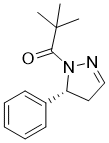This product is for research use only, not for human use. We do not sell to patients.

| Size | Price | Stock |
|---|---|---|
| 5mg | $120 | To Be Confirmed |
| 10mg | $210 | To Be Confirmed |
| 25mg | $400 | To Be Confirmed |
| 50mg | $650 | To Be Confirmed |
| 100mg | $1050 | To Be Confirmed |
| 250mg | $1850 | To Be Confirmed |
| 500mg | $2550 | To Be Confirmed |
Cat #: V3291 CAS #: 2049872-86-6 Purity ≥ 98%
Description: GSK-962 (also known as GSK'962 or GSK962) is a negative control for GSK'963 (also known as GSK'963 or GSK963). GSK-963 is a potent and selective RIP1 kinase inhibitor. GSK'963 is significantly more potent than Nec-1 (a known RIP1 kinase inhibitor ) in both biochemical and cellular assays, inhibiting RIP1-dependent cell death with an IC50 of between 1 and 4 nM in human and murine cells. GSK'963 is >10 000-fold selective for RIP1 over 339 other kinases, lacks measurable activity against IDO and has an inactive enantiomer, GSK'962, which can be used to confirm on-target effects. The increased in vitro potency of GSK'963 also translates in vivo, where GSK'963 provides much greater protection from hypothermia at matched doses to Nec-1, in a model of TNF-induced sterile shock. Together, we believe GSK'963 represents a next-generation tool for examining the function of RIP1 in vitro and in vivo, and should help to clarify our current understanding of the role of RIP1 in contributing to disease pathogenesis.
Publications Citing InvivoChem Products
Product Promise

- Physicochemical and Storage Information
- Protocol
- Related Biological Data
- Stock Solution Preparation
- Quality Control Documentation
| Molecular Weight (MW) | 230.31 |
|---|---|
| Molecular Formula | C14H18N2O |
| CAS No. | 2049872-86-6 |
| Storage | -20℃ for 3 years in powder form |
| -80℃ for 2 years in solvent | |
| Solubility In Vitro | DMSO: 10 mM |
| Water: N/A | |
| Ethanol: N/A | |
| SMILES Code | CC(C)(C)C(N1N=CC[C@@H]1C2=CC=CC=C2)=O |
| Synonyms | GSK-962; GSK 962; GSK962; GSK'962; GSK' 962 |
| Protocol | In Vitro | In vitro activity: GSK-963 (also known as GSK'963 or GSK963), is a potent and selective RIP1 kinase inhibitor. GSK'963 is significantly more potent than Nec-1 (a known RIP1 kinase inhibitor ) in both biochemical and cellular assays, inhibiting RIP1-dependent cell death with an IC50 of between 1 and 4 nM in human and murine cells. GSK'963 is >10 000-fold selective for RIP1 over 339 other kinases, lacks measurable activity against IDO and has an inactive enantiomer, GSK'962, which can be used to confirm on-target effects. The increased in vitro potency of GSK'963 also translates in vivo, where GSK'963 provides much greater protection from hypothermia at matched doses to Nec-1, in a model of TNF-induced sterile shock. Together, we believe GSK'963 represents a next-generation tool for examining the function of RIP1 in vitro and in vivo, and should help to clarify our current understanding of the role of RIP1 in contributing to disease pathogenesis. Kinase Assay: Compound potency against RIP1 kinase activity was determined using an ADP-Glo luminescence assay, which measures the conversion of ATP to ADP as previously described. In brief, the primary reaction consisted of 10 nM GST-RIPK1 (1–375) and 50 μM ATP in 50 mM HEPES pH 7.5, 50 mM NaCl, 30 mM MgCl2, 1 mM DTT, 0.5 mg/ml BSA, and 0.02% CHAPS. Five microliter of enzyme and 5 μl of ATP were added to the plate at twice the final assay concentration and incubated at room temperature for 4 h. The luminescence was measured on a plate reader. Test compound inhibition was expressed as percent inhibition of internal assay controls. Cell Assay: Necroptotic cell death was induced in BMDM, L929 and U937 cells with TNF in the presence of caspase inhibitor zVAD-FMK or QVD-Oph (BMDM: 50 ng/ml TNF+50 μM zVAD; L929: 100 ng/ml TNF+50 μM QVD; U937: 100 ng/ml TNF+25 μM QVD). To evaluate the effect of RIP1 inhibitors, cells were pretreated with compound (dose–response) for 30 min. Induced cell death was evaluated 19–21 h later by measuring cellular ATP levels using CellTiter-Glo Luminescent Cell Viability assay (Promega, Fitchburg, WI, USA). To induce necroptosis in neutrophils, freshly isolated human neutrophils were stimulated with TNF (10 ng/ml), QVD-Oph (50 μM) and SMAC mimetic (100 nM). Induced cell death was evaluated as above. |
|---|---|---|
| In Vivo | C57BL/6 mice were purchased from Taconic and housed under specific pathogen-free conditions. All animal procedures were conducted in an Association for Assessment and Accreditation of Laboratory Animal Care-accredited facility at GlaxoSmithKline in accordance with the GlaxoSmithKline Policy on the Care, Welfare, and Treatment of Laboratory Animals and were reviewed and approved by the Institutional Animal Care and Use Committee at GlaxoSmithKline. | |
| Animal model | C57BL/6 mice |
| Solvent volume to be added | Mass (the weight of a compound) | |||
|---|---|---|---|---|
| Mother liquor concentration | 1mg | 5mg | 10mg | 20mg |
| 1mM | 4.3420 mL | 21.7099 mL | 43.4197 mL | 86.8395 mL |
| 5mM | 0.8684 mL | 4.3420 mL | 8.6839 mL | 17.3679 mL |
| 10mM | 0.4342 mL | 2.1710 mL | 4.3420 mL | 8.6839 mL |
| 20mM | 0.2171 mL | 1.0855 mL | 2.1710 mL | 4.3420 mL |
This equation is commonly abbreviated as: C1 V1 = C2 V2
- (1) Please be sure that the solution is clear before the addition of next solvent. Dissolution methods like vortex, ultrasound or warming and heat may be used to aid dissolving.
- (2) Be sure to add the solvent(s) in order.




































